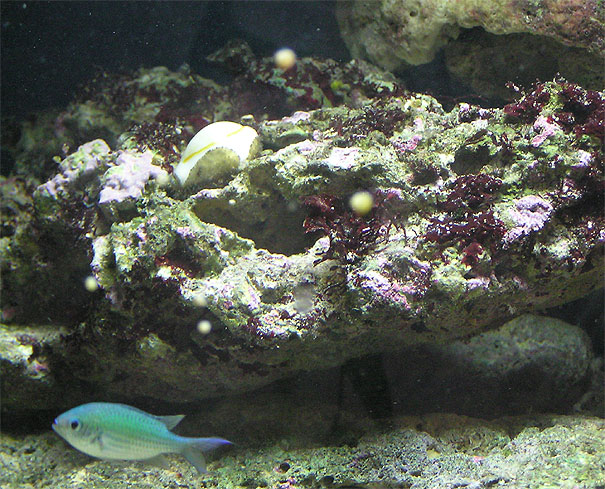To the right you can see it doing its imitation of a bomber-run, dropping ordonnance all over the landscape below... It was quite an active little fish, and proved difficult to photograph as you can see.
I started setting up my first indoor aquarium in March, 2004. Having decided I liked the hobby, this first tank was joined by a second of similar size, which I linked to the first to form a single unit. the first tank was as follows:
Kind: tropical marine; "live-rock with fish only" (near enough...)Inhabitants
Dimensions: 90 x 45 x 45 cm (approx. 165 litres)
Water temperature: 25 degrees
Water pH: ca. 8.3
Water specific gravity: ca. 1.023. This varied quite a bit upwards at times.
Fish:All these can be found in southern Japanese waters, around the Ryukyu islands. It was during a trip to Okinoerabu-jima in May 2003 that I decided it would be great to have some fish like the ones I saw there swimming around in my own living room... It's shame I don't have the space for a trigger fish!1 x Valenciennea strigata, Blue-cheeked goby, Yellow-headed sleeper goby, akahachihaze in JapaneseInvertebrates:
2 x Chromis viridis, Green chromis, debasuzume in Japanese
1 x Nemateleotris magnifica, Fire dartfish, Fire dart goby, Red firefish, hatatatehaze in Japanese3 x Cypraea annulus, Gold ringed cowry, hanabira takaragai in Japanese
Dozens of one the Trochidae species of snail, nishikiuzugai in Japanese
Several unidentified hermit crabs brought from Ishigaki-jima
|
The Valenciennea strigata one day simply went missing. Since we had what we suspected was a hitch-hinking mantis shrimp at the time, it may have fallen prey. However it may have died for some other reason; it never took to eating food introduced into the tank, and may have starved from not getting enough from sifting the substrate. I don't think I will be getting another as a consequence; althought it was an enteratining fish, it was quite a problem, since its habit of dumping sand all over the rockwork made for a lot of maintenance problems.
To the right you can see it doing its imitation of a bomber-run, dropping ordonnance all over the landscape below... It was quite an active little fish, and proved difficult to photograph as you can see.
|
|
Initially we had two Nemateleotris magnifica, but one didn't survive very long for unknown reasons.
Below you can see a Gold ringed cowry, and in the foreground, a Green chromis. The cowrie has (unusually) withdrawn most of its mantle, allowing the shiny shell with its characteristic decoration to be seen. Usually the olive mantle covers essentially all of the shell, and is only withdrawn when the animal is threatened.

The Gold ringed cowry (cowrie), ie. Cypraea annulus is called a hanabira takaragai in Japanese, which means 'petalled treasure-shell'. Cowries shells were used as currency units in many Pacific Island economies before European contact.
This page created 10 July 2004, and last modified 10 July 2004.
Go to my home-page index.